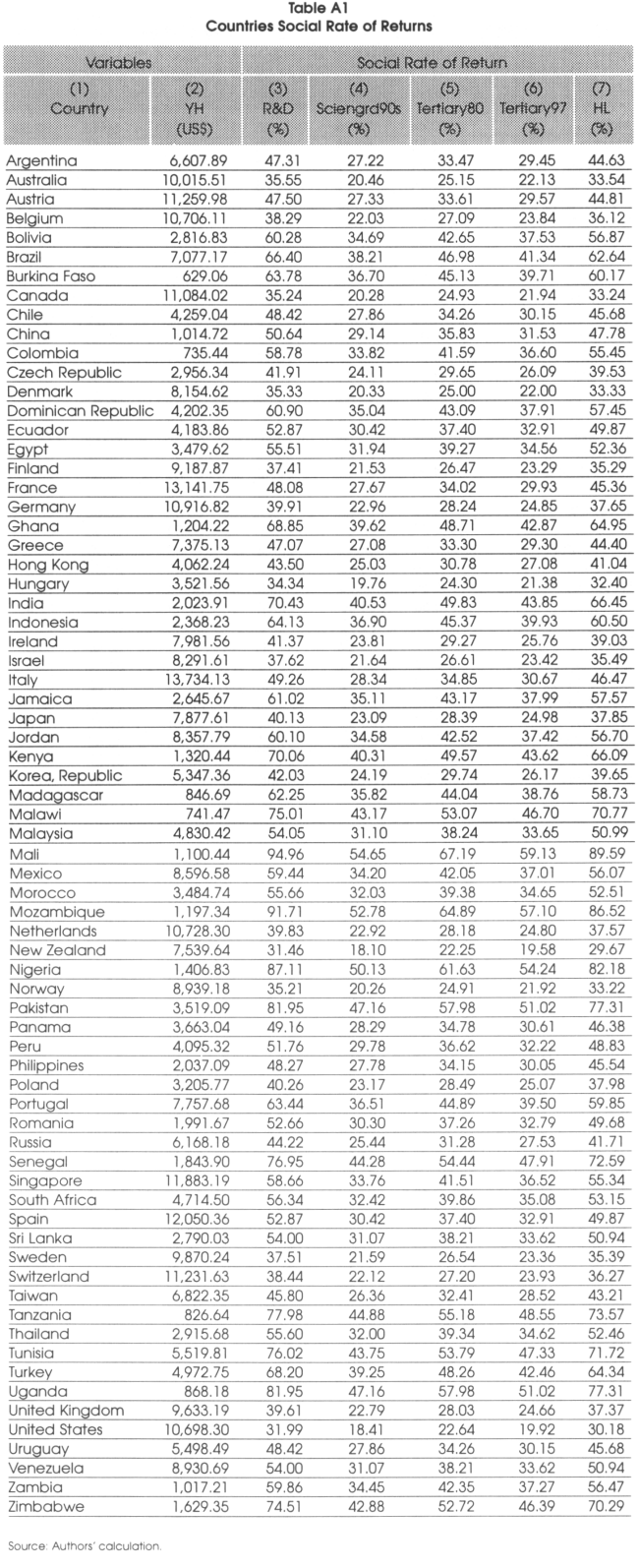Services on Demand
Journal
Article
Indicators
-
 Cited by SciELO
Cited by SciELO -
 Access statistics
Access statistics
Related links
-
 Similars in
SciELO
Similars in
SciELO
Share
Revista Latinoamericana de Desarrollo Económico
Print version ISSN 2074-4706On-line version ISSN 2309-9038
rlde no.7 La Paz Oct. 2006
The Social Rates of Return to R&D, Scientists, Engineers and Tertiary Education System Investments: International Evidence
Joilson Dias, María Helena Ambrosio Dias*
Abstract
The objective of this paper ¡s to estimate the social rates of returns to tertiary education investment and its output R&D and scientists and engineers in the economy. In measuring this social impact, we account for the endogeneity problems using instrumental variables. Our instruments are the ones suggested by Hall and Jones (1999). Our econometric results show that the investments variables are indeed endogenous and that our instruments indeed represent the social capital of the economies. The estimated social rates of return to the investments in R&D, scientist and engineers and tertiary education for 70 countries are well above the private one, which may justify targeted policies.
Resumen
El objetivo de esta investigación es la estimación de las tasas sociales de retorno de la inversión en educación terciaria y su producto I&D y científicos e ingenieros en la economía. En la medición de este impacto social, tomamos en cuenta los problemas de endogeneidad, utilizando variables instrumentales. Los instrumentos utilizados son aquéllos sugeridos por Hall y Jones (1999). Los resultados econométricos muestran que las variables de inversión son endógenas al modelo y que los instrumentos representan efectivamente el capital social de las economías. Las tasas sociales de retorno estimadas para las inversiones en I&D, científicos e ingenieros, y en educación terciaria para 70 países están por encima del retorno privado, lo cual justificaría una orientación de las políticas.
1. Introduction
The objective of this paper is to obtain cross-country social rates of return for the investment being made in the tertiary education infrastructure and its output scientists and engineers in the R&D sector. In this way, our study follows Adams (1990) research that linked the academic science output in the form of papers, scientists and engineers to the productivity growth in US manufacturing industries. We extend the author's core idea by measuring these social rates of return as a proportion of the human capital of each country. The human capital function to be used was developed by Hall and Jones (1999).
Most of the studies in social rate of return to education are made at micro level, e.g. the studies reported in Psacharopoulos (2004), and not at macro level like ours. At macro level, the tertiary education is regarded as investment in human capital made by society. In this way, our research is linked to the seminal work done by Mankiw, Romer and Weill (1992). They have estimated the importance of the human capital to economic growth by using secondary education enrollment as a proxy for human capital investment. Indeed, what the authors have estimated was the social rate of return to that investment, as we will show afterward. Here, besides measuring it for the tertiary educational system, we also innovate by computing the social rate of return as proportion of the human capital per worker in each country.
The other innovative aspect is the use of social capital as the exogenous element in our specification. Thus, the social capital is the key determinant of investment in tertiary education and scientists' allocation to the R&D sector1. Therefore, we follow Hall & Jones (1999), Spencer and Gomez (2003) and Dias and McDermott (2005) in this specification.
In a more broad view, our research has links with the economic development theory literature. The human capital accumulation in general increases growth rates as proposed in Lucas (1988). The importance of high-qualified human capital in the R&D sector also generates economic growth was showed by Romer (1990). Moreover, Aghion and Howitt (1998) demonstrated how the developments of new technologies by the human capital in the R&D sector affects the long run growth of the economy. Thus, investment in higher education that generates human capital for the R&D sector will generate increasing benefits for the long-run growth of the economy, in accordance with these studies. Thus, we expect to find a high social rate of return to these investments.
On the econometric side, we plan to deal with the endogenous problem, common to this type of study, by making use of IV-Instrumental Variables. Our instruments will be a measure of social capital proposed by Hall and Jones (1999). The overidentification and endogeneity tests to be run shall confirm the quality of the instruments.
Our paper is organized as follow. Section II briefly reviews the social rate of return to R&D investment. Section III presents the model to be estimated; Section IV describes the data and the econometric results. The last section is our conclusion.
2. The Social Rate of Return to R&D
Measuring social rate of return to R&D is quite common nowadays. This fast growing literature encompasses measurement made within countries, countries' industries, as a spillover effect between and among countries, and over cross-country dynamic panel. The social rate of return to R&D became a very important mechanism of measuring the spillover effect of the investment made by the society. Thus, the attention is not just on the direct return from the investment itself, but also on the social or spillover effect of this investment. If the social rate is above the private one then public investment may be justified under a social premise2. Jones and Williams (1998) found the optimal level of R&D investment to be between two to four times above the actual level of investment in US. We report below some common findings.
The estimated rates of return to R&D at the industry level in US ranges from 17% to as much as 30% (Sveikauskas, 1981, Griliches, 1994). However, when considered the social rate of return it goes to as much as 100% as in Scherer (1982), and Jones and Williams (1998). The other example of high social rate of return was found in Canadian equipment communication industry. Bernstein (1996) estimated it to be around 55%, which is 225% higher compared to the private one.
The cross-country studies have also found a quite large social rate of return to R&D investment. The impact of 1 % increase in business R&D investment is around 0.13% in 16 OECD productivity growth; however, the same amount of foreign R&D investment generates 0,46% in the productivity growth (Guellec and Potterie, 2001). This intra-country spillover was measured by Coe et al. (1 997) through the social rate of return to R&D for 15 OECD countries. There, they found it to be around 85%. Using a more complete panel dataset Lederman and Maloney (2003) found this rate to be between 20%-40% for OECD countries, an average 60% for medium income countries (Mexico and Chile), and 100% in poor countries (Nicaragua and Nigeria). The overall social rate of return is in the range 102%-133% depending upon the sample size used by the authors. This literature, in general, does not take into consideration the stock of human capital when estimating the social rate of return to R&D.
As we saw above, the social rate of return seems to justify government policies that subsidies R&D investment. Moreover, it also may justify a more intensive investment in existing tertiary education as way of outputting new scientists and engineers for the R&D sector. The next section is in charge of estimating the proposed social rates of returns.
3. The Model
In estimating the social importance of tertiary education system and its output-scientists and engineers, we use Griffith (2000) methodology. The methodology can be easily described by considering the following aggregate production function.
![]()
Where Yi is the output obtained from combining the physical capital (Ki) and labor (Li) in country i, and Ai is the total factor productivity (TFP) of that country. The TFP may be affected by several factors other them the stock of knowledge, Hi, which is our main focus here. We assume it to have the following form Ai=aHξiXβi. Thus, the overall effect can be written in the log form as
![]()
Where α=log(a) the constant term and Xi denotes all the other factors. The elasticity of TFP with respect to knowledge is
![]()
The social return due to human capital ri=(∂Yi/∂Hi) is related to the above elasticity. To show that, first, we take the derivative of equation (1) with respect to H. The resulting equation is the following one:
![]()
By solving equation (3) for ∂Ai/∂Hi, and placing it in equation (4) we get the following:
![]()
According to equation (1) the following is true ∂Yi/∂Ai= F(KiLi) and Ai= Yi/F(KiLi). Thus, we replace these definitions in equation (5) to get
![]()
Thus, the social return to human capital is directly related to the output per human capital. This can be easily computed by estimating the elasticity of TFP with respect to knowledge, ξ, in equation (2). In this case, it is the same as the elasticity of output with respect to knowledge3. To compute the social rate of return, we simply divide the return in equation (6) by the total output.
Hence, our objective is to estimate equation (2) by considering potential measures of investment in producing knowledge in the economy This will enable us to learn about the social impact of the tertiary educational infrastructure and its output engineers and scientists dedicated to R&D processes. As we shall see, we first follow the literature and compute the social rate of return to the amount invested in R&D.
4. The Variables
We have gathered data from different sources in order to generate a dataset that would enable us to achieve our goals. The first and foremost problem concerns the control variables (Xi) that enter in the estimation of the equation (2). These variables should represent the fixed elements that distinguish each country fixed effects and most important of all be independent of explaining variables.
Taking the above into consideration, we follow Hall and Jones (1999) and select two variables to represent the social capital of the economy:
i) LogFR is the Log of predicted share of an economy (LogFR) based on a gravitational model that uses only population and international trade for the year 1996. The source is Frankel and Romer (1996). This is an index number, according to Table 1, which has an average of 2.59.
ii) Eurfrac is the fraction of population speaking one of five European languages (Eurfrac) for the year 1992: Portuguese, French, Italian, Spanish and English. The source is Hunter (1992). The average of sample of countries is 30.8%. It goes from zero (like Japan) to as much as 100% (European countries in general).
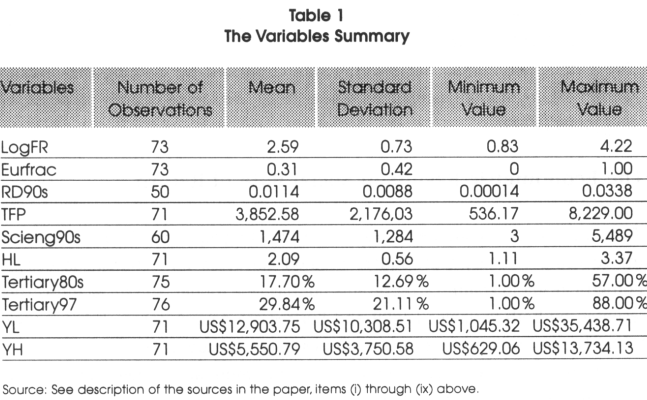
Hall and Jones (1999) used these two variables to represent the exogenous social infrastructure of a country and, therefore, to minimize the omitted variables problem. By social capital or infrastructure, the authors mean the institutions and government policies that determine the economic environment in which economic agents accumulate physical and human capital necessary to produce output. Taken together these two variables supposedly represent all the social-economic differences among countries. Thus, our variables would measure more precise the social rate of return because it would not be influenced by omitted countries differences. The summary of the remaining variables are in Table 1. Their descriptions are
iii) The average 1990's (1991-1999) R&D investment measured as a proportion of the output (RD90s). The source of the data is World Bank (2001). The average was 1.14% with some countries investing as little as 0.014 %; the maximum percentage of output invested was 3.38 %;
iv) The average 1990's (1991-1999) TFP-Total Factor Productivity for the countries. The source is Hall and Jones (1999). This variable has an average value of 3.852,58; it measures the total impact of the inputs on output;
v) The average 1990's (1991-1999) number of scientists and engineers allocated to the R&D sector (Scieng90s) per million individuals of each country. The source is World Bank (2001). The minimum number of scientists and engineers per million people allocated in the R&D sector was 3 and the maximum was 5,489 with the average sample being 1,474;
vi) The variable average human capital per worker (HL) comes from the study done by Hall and Jones (1999). They use the rate of return to education to build a piecewise human capital function per worker for each country for the year 1996. The average 2.09 shows the human capital productivity of the countries sample. It ranges from 1.11 to as much as 3.37 the maximum productivity;
vii) The average 1980's (1981-1989) enrollment in tertiary education as percentage of relevant age group (Tertiary80s) is from World Bank (2001);
viii) The 1997's enrollment in tertiary education as percentage of relevant age group; (Tertiary97) is from World Bank(2001);
ix) The output per human capital (YH) was computed by dividing the output per worker (YL) by human capital per worker (HL). The source of both variables is Hall and Jones (1999).
5. The Econometric Results of Social Rate of Return
Table 2 shows the econometric results of estimating equation (2). The models were estimated using ordinary least square method corrected for heteroskedasticity. The econometric result in column 1 represents our baseline model. The social infrastructure represented by both variables LogFR and Eurfrac are determinants of the changes in TFP-Total Factor Productivity of the countries as postulated in Hall and Jones (1999). The social infrastructure is also found to be quite important in determining long-run human capital accumulation as in the studies done by Spencer and Gomez (2003) and Dias and McDermott (2006).
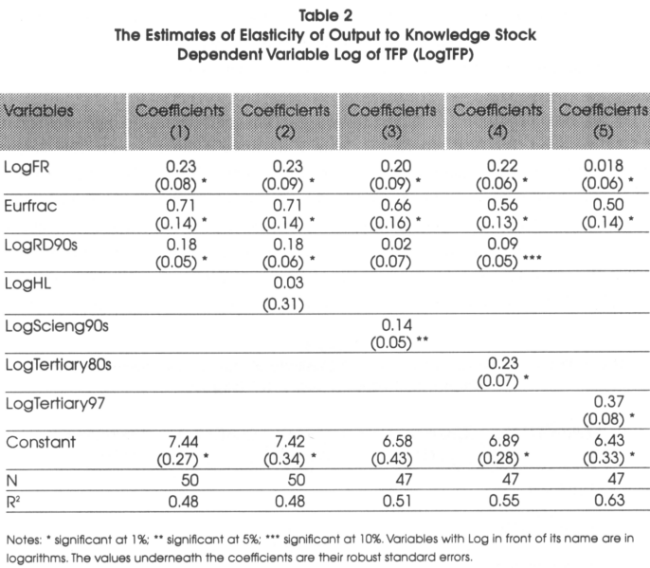
As one may notice in column (1) of the above table, the coefficient on the Log of RD90s (LogRD90s) is the elasticity of output with respect to knowledge stock ξ = 0.18. In order to compute the social return to R&D investment, we use the sample ratio Yi/Hi = $5,550.79. Using these two values, we have that the ri = $999.14 dividing this for the average output per worker $12,903.75 gives us a social rate of return of 7.74%. Using the same methodology, the estimate social rates of return to scientists and engineers (column 3 of Table 2), tertiary education in the 80's and 90's (column 4 and 5 of Table 2) are: 6.0%, 9.9 56 and 15.9% respectively. These rates are far below the estimated ones reported in the literature. Although these estimates may lie within a range that might explain why the investment in R&D and in highly qualified human capital is not a worldwide tendency, nonetheless they seem not be very plausible. The question is how we reconcile these results with the previous mentioned literature.
We believe the answer to be in the way of computing the social rate of return. Let us take the social rate of return to R&D, column 1 of Table 2, as example. First, we take the sample average Yi/Ai = 3.35 as a proxy for Yi/Hi. The papers mentioned earlier on use this, since the output per human capital is not easily available. After that, we multiply the ratio result for the output elasticity to knowledge 0.1 8 which give us a rate of 60.28 %.
Hence, by calling it social rate of return, we got a value that is in the same range as the previously mentioned authors. However, by considering it as being the social rate of return, we might be overestimating the true social rate of return. The over estimative would happen whenever the investment variables are endogenous to the model.
One way to solve the endogenous problem is to find instrument variables that are related to the variables R&D investment, scientist and engineers in the R&D sector and tertiary education infrastructure that is independent of TFP. Here, we follow Hall and Jones (1999) study. In explaining TFP, they used the LogFR and the Eurfrac as instrumental variables for human capital per worker. If these variables are valid instruments for human capital, they also must be valid for R&D investment, scientists and engineers in the R&D sector and tertiary education infrastructure. In this case, the social infrastructure captured by the two proposed variables (LogFR and Eurfrac) is the key elements in determining the R&D investment, number of scientist and engineers in the R&D sector and the size of the tertiary educational system. The results are reported below, Table 3.
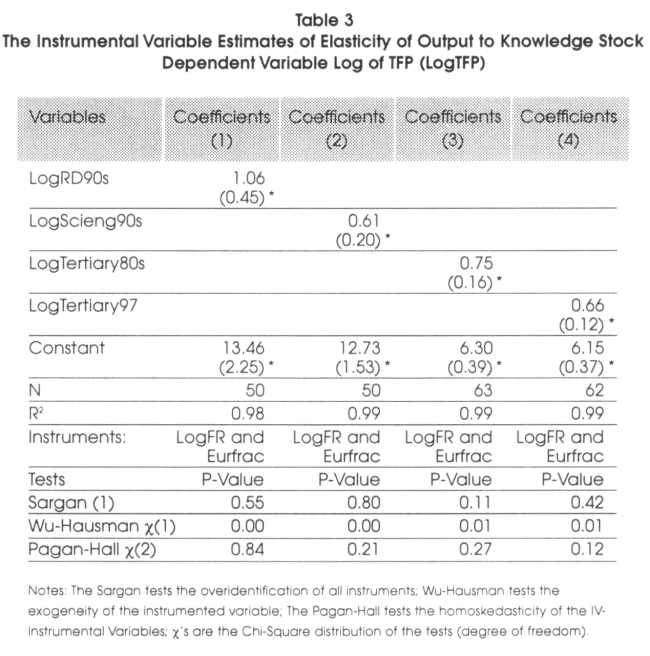
All regressions reported in Table 3 show significant coefficients and high coefficient of determination (R2). Also reported in Table 3 are three additional tests. The Sargan (1958) test is a test of validity of the instrument variables. The null hypothesis of this test is that the instruments are uncorrelated to the set of residuals. According to this criterion, the estimated probabilities of accepting the null hypotheses are all above 10%, the minimum required. The Wu (1973) and Hausman (1978) tests were combined in the Wu-Hausman test for exogeneity of the instrumented variables LogRd90s, Scieng90s, Tertiray80 and Teritiary90. The probabilities of the null hypothesis of being exogenous are reported in Table 3 for the variables. Those probabilities reject the exogeneity of those variables. Finally, we have the Pagan and Hall (1983) tests for heteroskedasticity. The probabilities reported in Table 3 are for the null hypothesis of being homoskedastic. Thus, our regressions seem to support the constant variance case.
Although not reported, we made additional tests for the quality of the instrument variables. We introduced indicator variables suggested by World Bank (2001). These indicator variables represent countries according to their region and are EAP-East Asia Pacific; ECA-East Europe and Central Asia; MENA-Middle East and North Africa; SA-South Asia; WE-West Europe; NA-North America; SSA-Sub-Sahara Africa; LAC-Latin American Countries. None of these indicator variables showed to be significant either alone or in combination. In another words our instrument variables seems to capture very well their characteristics, therefore indicating that their actual condition is very much related to the proposed social capital representing variables.
In general, the tests results clearly indicate that the investment variables are endogenous, as predicted previously, and give a strong support for the quality of the instrument variables. The remaining econometric results are described below.
In Table 3, first column, the output elasticities regarding investment in R&D is 1.06 with the lowest being for the scientists and engineers in the R&D sector of 0.61. While the first measures the amount invested, the second measures the allocation of qualified human capital in the R&D sector as proposed by Romer (1990). These elasticities are close to the ones obtained by Mankiw, Romer and Weil (1992). Using the percentage of the working-age population that is in the secondary school, they obtained the following elasticities: Non-oil countries 0.66, intermediate ones 0.73, and for the OECD 0.76. Moreover, their estimates were found to be robust by a Monte Carlo study done by Hauk and Wacziarg (2004).
We use the estimated coefficients of elasticities in Table 3 together with the output per human capital of each country to compute the social rate of return. We apply the formula of equation (6) in computing the social return to the investments made either in R&D, scientists and engineers or tertiary education infrastructure. Dividing the obtained social returns by output per worker it give us the social rate of return to these investments. We report those rates in Tables A4 and A5 in the Appendix.
In column 2 of mentioned Appendix is reported the output per human capital. The social rate of return for investment in R&D, human capital, tertiary education infrastructure in 1980 and 1990 and human capital per worker are represented in columns (3) through (7), respectively Column (7) is computed simply by the division of YH by YL or output per human capital by output per worker This social rate of return captures the investment made in education in general; therefore, it enables us to compare the three type of investment in education being made. The first is in producing highly qualified human capital scientists and engineers; the second on access to tertiary education; and the third one in education in general. In order to have a broad vision of theses results, we have produced Table 4 below that summarizes the results by output per human capital ranges.
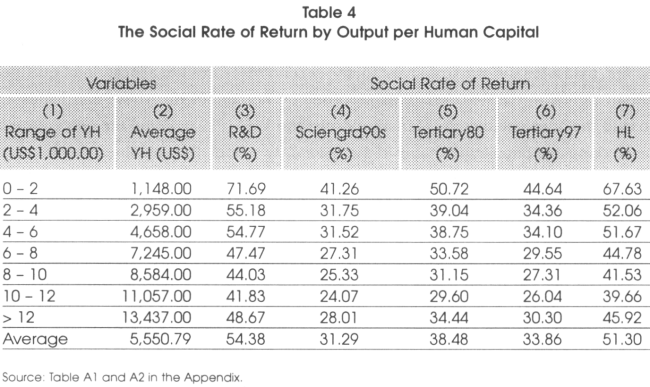
According to Table 4, the average output per human capital and social rate of returns in our sample are the following ones: The YH is US$ 5.550,79, the average rate of return to R&D is 54.38%; the Sciengrd90s rate is 31.29%; the Teritary80 is 38.48%; the Tertiary97 is 33.87%; the general education HL is 51.30%. These average rates are well above the private rate suggested by Hall and Jones (1999) of 7%. This clearly justifies society's investment in any of the above elements.
Countries with the highest rates have an output per human capital below US$ 2,000.00 and the ones with the lowest in the range of US$10,000.00-US$ 12,000.00. The two countries with output per human capital above US$ 12,000.00 are France and Italy. Their social rates of return are not in the expected range ones.
We estimate the country with the highest social rate of returns to be Mali. Nonetheless, the lowest rates belongs to New Zealand, followed closely USA. In order to have a better idea on the social rate of returns, we have produced the graph below.
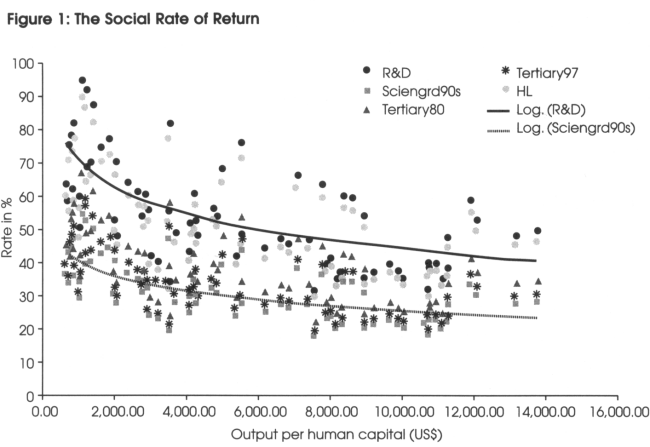
In general, countries with lower output per human capital tend to have higher social rate of returns. These rates seems to follow a log function in the sense that they are higher for countries with low human capital per worker and lowers as more human capital get accumulated. If these rates indeed follow a log function then in the long run they will tend to stabilize at some level.
Another important issue when comparing the social rates is learning about the best policy to be chosen in order to have the highest return. We find that R&D and HL rates are very close. The decision on where to invest should be a matter of cost analysis. For countries with very low human capital per worker, like Brazil, the investment must be education in general that improves HL and enable the country to collect the social benefit of the investment being made in a faster way. In this case, the tertiary education investment has the advantage of improving HL and later on to generate more scientist and engineers for the R&D sector, hence an even great spillover effect. In United States, we guess that the investment in R&D probably will be less costly than any investment that would improve the overall country human capital per worker. Recall that United States has a high rate of access to tertiary education 81 % in 1997, according to World Bank (2001). It would require an even far great access for future generations in college education to improve HL. This would be a very long-term commitment policy compared to investing in the R&D sector. Thus, the R&D investment would generate almost the same social return and would require much less time burdening. In our view, countries that provide high access to education in general will naturally invest more in R&D as way of collecting the same social benefits.
6. Conclusion
Our econometric results showed that variables regarded as investment in highly qualified human capital like R&D, scientists and engineers and tertiary education are endogenous to social infrastructure of the economy. Therefore, studies that do not consider this aspect might been incurring in econometric problems. Moreover, this also means that the social infrastructure accounts for most of the investment being made. As these investments increases their social rates of return tends to lower.
Under this view, our research seems to supports an economic development process that has the tertiary education as the centerpiece in producing human capital. The investment in tertiary education helps to improve human capital per worker in general and has a high social rate of return. Moreover, it also generate as output scientists and engineers that would be used by the R&D sector later on. Therefore, this policy would produce a spillover effect of massive proportions to the economy. Hence, there is high social gain to be made by investing in tertiary education system in those countries with lower human capital per worker. For those countries in which there is already a high access to tertiary education, the best approach would be to direct most of the investment to R&D.
Notas
* Profesores-Investigadores, Departamento de Economía, Universidade Stadual de Moringa, Brazil.
1 Temple (2001) provides an excellent review on these two subjects.
2 The social rate of return measures the benefit to the users from the R&D investment while the private rate of return to R&D measures the benefit accruing to the investors.
3 This can be easily demonstrated by taking log of equation (1) and substituting in it equation (2). The derivative of the resulting equation with respect to human capital is the proposed elasticity.
References
Adams, J. D. 1990. "Fundamental Stocks of Knowledge and Productivity Growth". Journal of Political Economy, 98(4):673-702.
Aghion, P., and P. Howitt. 1998. Endogenous Growth Theory. London: The MIT Press.
Archibald, R. B., and D. H. Finifter. 2003. "Evaluating the NASA Small Business Innovation Research Program: Preliminary Evidence of a Trade-Off Between Commercialization and Basic Research". Research Policy, 32(4):605-619.
Audretsch, D. B. 1995. "Intellectual Property Rights. New Research Directions". In: Albach, H. and S. Rosenkranz, (eds). Intellectual Property Rights and Global Competition: Towards a New Synthesis. Berlin:WZB.
Baumol, W. J. 1990. "Entrepreneurship: Productive, Unproductive, and Destructive". Journal of Political Economy, 90(5):893-921.
Bernstein, J I. 1996. "R&D and Productivity Growth in Canadian Communications Equipment and Manufacturing". Industry Canada Working Paper 10, Ottawa. Ontario, Canada.
Cameron, G., J. Proudman and S. Redding. 2004. "Technological Convergence, R&D, Trade and Productivity Growth". European Economic Review. Forthcoming.
Coe, D T, E. Helpman and A. W. Hoffmaister. 1997. "North-South R&D Spillover". Economic Journal, 107(440): 134-139.
Damijan, J. P., M. Knell, B. Majcen and M. Rojec. 2003. "The Role of FDI, R&D Accumulation and Trade in Transferring Technology to Transition Countries: Evidence From Firm Panel Data for Eight Transition Countries". Economic Systems, 27(2): 189-204.
Dias, J., and J. McDermott. 2005. "Education, Institutions, and Growth: The Role of Entrepreneurs". Journal of Development Economics, 80(2):299-328
Djankov, S., R. LaPorta, F. Lopez-De-Silanes and A. Shleifer. 2002. "The Regulation of Entry". The Quarterly Journal of Economics, 117(1): 1-37
Frankel, J. A. and D. Romer, 1996. "Trade and Growth: An Empirical Investigation". NBER Working Paper N° 5476.
Goldfarb, B., and M. Henrekson. 2003. "Bottom-up Versus Top-Down Policies Towards the Commercialization of University Intellectual Property". Research Policy, 32(4):639-658.
Gregorio, D. D., and S. Shane. 2003. "Why do Some Universities Generate More Startups than Others?". Research Policy, 32(2):209-227.
Griffith, R. 2000. "How Important is Business R&D for Economic Growth and Should the Government Subsidize it?". Institute For Fiscal Studies, Briefing Note N. 12, London.
Griliches, Z. 1 994. R&D and Productivity: The Econometric Evidence. Chicago: Chicago University Press.
Guellec, D., and B. V. P. Potterie. 2001. "R&D and Productivity Growth: Panel Data Analysis of 16 OECD Countries". OECD-STI Working Papers 2001/3, Paris, France.
Hall, R. E., and C. I. Jones. 1999. "Why do Some Countries Produce so Much More Output per Worker than Others?" The Quarterly Journal of Economics, 114(0:83-116.
Hauk, W. R., jr., and R. Wacziarg. 2004. "A Monet Carlo Study of Growth Regressions". NBER Working Paper N° 296.
Hunter, B. F. 1992. Ethnologue: Languages of the World. Gothenburg: Lanstryckeriet.
Jensen, R. A., J. G. Thursby and M. C. Thursby. 2003. "Disclosure and Licensing of University Inventions: The Best We Can do With the S**t We Get to Work With". International Journal of Industrial Organization, 21 (9): 1271-1300.
Jones, C.I., and J.C. Williams. 1998. "Measuring the Social Return to R&D". The Quarterly Journal of Economics, 113(5): 1119-1135.
Lederman, D., and W. F. Maloney. 2003. "R&D and Development". Office of the Chief Economist, Latin America and Caribbean, World Bank, Washington-DC.
Link, A. N., andj. T. Scott. 2003. "US Science Parks: The Diffusion of an Innovation and Its Effects on the Academic Missions of Universities". International Journal of Industrial Organization, 21 (9): 1323-1356.
Link, A. N., J. T. Scott and D. S. Siegel. 2003. "The Economics of Intellectual Property at Universities: An Overview of the Special Issue". International Journal of Industrial Organization, 21 (9): 1 21 7-1225.
Lucas Jr., R. J. 1988. "On the Mechanics of Economic Development". Journal of Monetary Economics, 22(l):3-42.
Mankiw, G., D. Romer and D. Weil. 1992. "A Contribuition to the Empirics of economic growth". The Quarterly Journal of Economics, 107(2): 407-437.
Nekar, A., and S. Shane. 2003. "When do Start-ups that Exploit Patented Academic Knowledge Survive?" International Journal of Industrial Organization, 21 (9). 1 391 -1 410.
Pagan, A.R., and A. D. Hall. 1983. "Diagnostic tests as residual analysis". Econometric Reviews, 2(1): 159-218.
Psacharopoulos, G. 2004. "Returns to investment in education: a further update". Education Economics, 12(2): 111-134.
Romer, P.M. 1990. "Endogenous Technological Change" Journal of Political Economy, 98(5):S71-S102.
Romer, P.M. 1996. "Why, Indeed, in America? Theory, History, and the Origins of Modern Economic Growth". The American Economic Review, 86(2):202-206.
Shane, S. 2004. "Encouraging University Entrepreneurship? The Effect of the Bayh-Dole Act on University Patenting in the United States". Journal of Business Venturing, 19(1):127-151.
Sargan, J.D. 1958. "The Estimation of Economic Relationship Using Instrumental Variables". Econometrica, 26(2):393-41 5.
Shane, S., and S. Venkataraman. 2003. "Guest Editors' Introduction to the Special Issue on Technology Entrepreneurship". Research Policy, 32(2): 181-1 84.
Scherer, F. M. 1 982. "Inter-Industry Technology Flows and Productivity Growth". Review of Economic and Statistics, 64(3):627-634.
Spencer, J. W, and C. Gomez. 2003. "The Relationship Among National Institutional Structures, Economic Factors, and Domestic Entrepreneurial Activity: A Multicountry Study". Journal of Business Research, 5878(1): 1-10.
Sveikauskas, L. 1981. "Technological Inputs and Multifactor Productivity Growth". Review of Economic and Statistics, 63(2):275-282.
Vohora, A., M. Wright and A. Lockett. 2004. "Critical Junctures in the Development of University High-Tech Spinout Companies". Research Policy, 33(1): 1 47-1 75.
World Bank. 2001. World Development Indicators 2001. Washington: World Bank CD-ROM.
Wu, D. M. 1973. "Alternative Tests of Independence Between Stochastic Regressors and Disturbances". Econometrica, 46(4):733-750.
